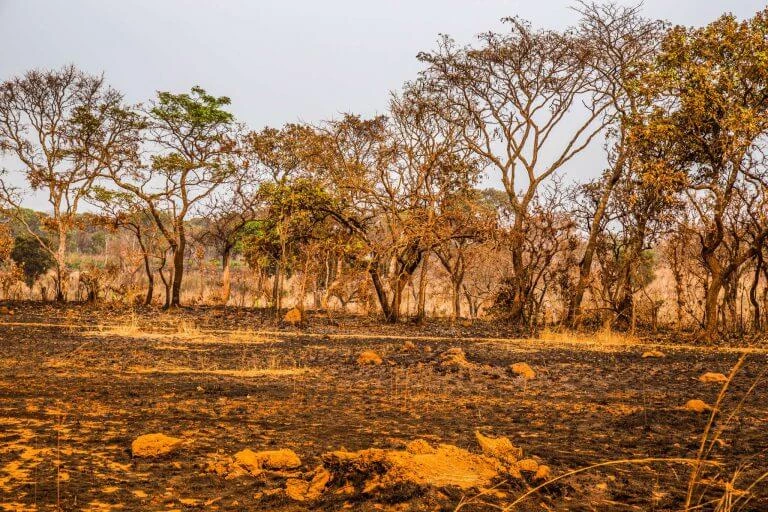Fire and dust
Sunday, September 25, 2016
- Three Continents
The first few kilometers to Bukoba still had a nice paved road. But that should be over soon. As soon as I came to the main road that connects Tanzania with Rwanda and Burundi, the condition of the road got worse and worse. Potholes without end and soon there was no more asphalt. After that, only endless corrugated iron roads followed. Impressive I find here really only the many locals who transport the most incredible things with their bikes.
Unfortunately the sunglasses broke on the second day. Another mishap followed the next day. In the morning I pushed my bike through the bush into the street. Suddenly the chain slipped off the chainring. Before I could even react, she had already caught herself between the chainring and the pinion. It took me three hours to knock the chain out with Allen key and stone again.

The dirt road to Kigoma goes along almost 300km along the Burundian border. Here came another evil. In addition to the reckless bus driving, there are a huge number of vehicles for aid organizations here. These are even more ruthless than the bus drivers. Every day I was deliberately pushed off the street several times. My middle finger was quite often used. By no means will I ever again support an aid organization in my life that I have seen here.
Due to the difficult situation in Burundi, several refugee camps are located here. The United Nations reports nearly 500 deaths last year; Recent data suggests that up to 1,500 people in the conflict between government and opponents of the regime may have died between April 2015 and April 2016, including 690 civilians. The African Union has refrained from plans to send a peacekeeping force; the taboo was too great to intervene against the will of a member state.

My list of the top 5 archenemies now looks like this:
Tanzanian bus driver
East African children
headwind
African mosquitoes
African flies
Of the many dust which stir up the vehicles, everything is just covered on the side of the road. Often I had to stop when vehicles drove past me because you could not see anything for a while.

In the villages I only stopped to buy water. Most of the time, a bunch of people stood around me in no time to just stare at me. The landscape is totally bleak here. On the one hand contributes to the slash and burn and also covers all the dust from the street the whole. On the 300km long corrugated run, I always had two songs in my head:

After 9 days I finally reached Kigoma on the shores of Lake Tanganyika. Moral and physically pretty much in the end. Actually I wanted to camp at the Jakobsen Beach Camp. This was much too expensive for me. The Aqua Lodge is being renovated but the manager still allowed me to pitch tent right on the shore. I was very lucky and was able to make a trip with the MV Liemba 3 days later. This only goes to Mpulungu in Zambia every 2 weeks.
The Liemba was built in 1913 as a steamship in Germany and armed during the First World War. Until May 16, 1927, it bore the name Goetzen, named after Gustav Adolf Graf von Goetzen. It was intended to promote the transport of goods on Lake Tanganyika, located in the former German colony of German East Africa and with the Belgian colony of Congo.
The ship was converted to an auxiliary warship during the First World War. When the German troops had to give up Kigoma on their retreat, the German Navy ordered commanders to sink the Goetzen. The ship's engineer had the major parts lubricated with grease before opening the seacocks and flooded the ship on July 26, 1916 at a depth of about 20 meters near the shore in the Katabe Bay. The ship was lifted from 1918 by the Belgians. Due to the beginning of the 1960s in the region erupting civil wars Liemba has been used since 1962 by the UNHCR often as a refugee van.
The ship is managed since 1977 by the Tanzania Railways Corporation (TRC). The Liemba is today the only large passenger ship that operates regularly on the lake. In part, it is only small villages that have no port. The loading and unloading takes place almost exclusively on small barges, since landing bridges are only in Kigoma, Kasanga and Mpulungu.

The ticket costs four times as much for foreigners as for locals. Such things are just making me a huge hit here in Africa. Everyone believes that the white Muzungus are rich people. Sometimes, when you are constantly begged for money, you almost go crazy. I paid 75.- US dollars for a ticket in third grade and fell asleep on the deck. Apart from that, the ride was a real experience and I came in contact with some very nice people. For example, Katharina, who works as a midwife in Chad, originally from Germany and has worked for a long time in Switzerland. She was accompanied by Herman, a friend from Hanover. The two drove all the way from Kigoma to Mpulungu every now and then. They invited me for lunch in their cabin. Many Thanks!
With a day delay we arrived after 3 days drive in Mpulungu. For this cruise, the expendable trip to Kigoma was definitely worth it. I am glad that I survived Tanzania without an accident. Unfortunately I can not recommend this country for other cyclists because of the bad roads and the ruthless driver. It's a pity, because there is a lot to discover and is very attractive in the countryside (if not everything is burnt down).